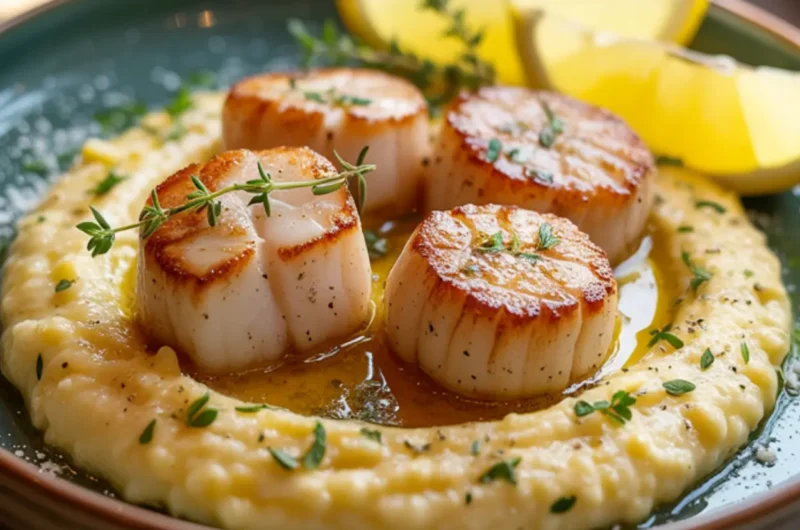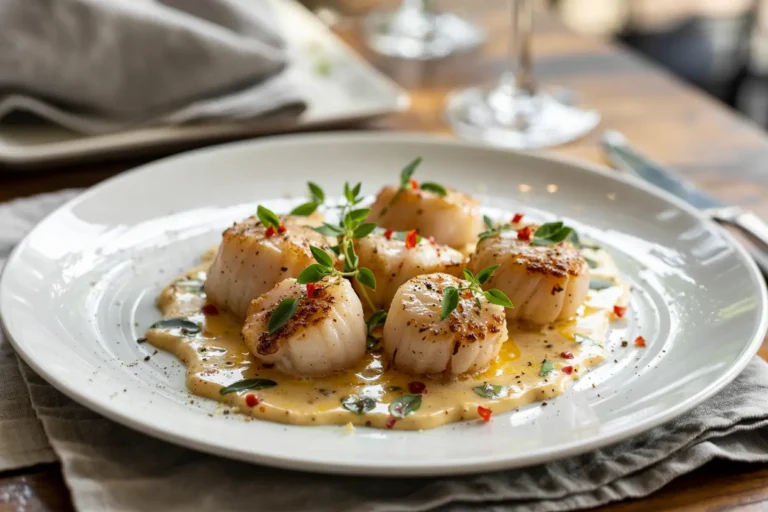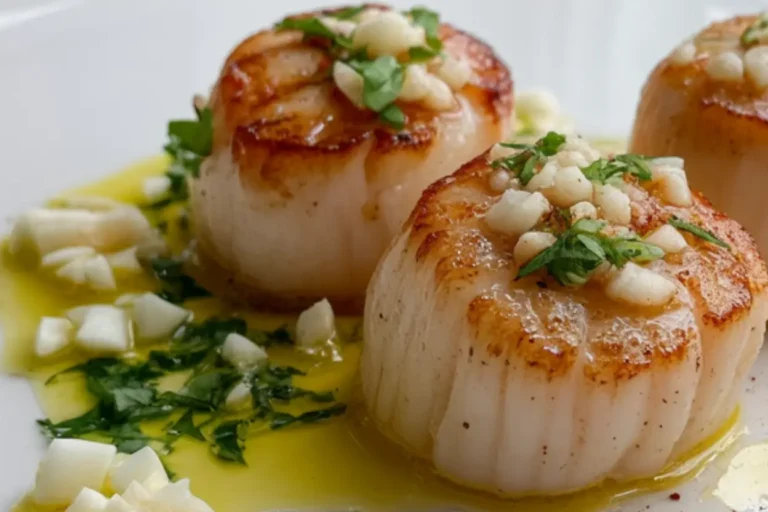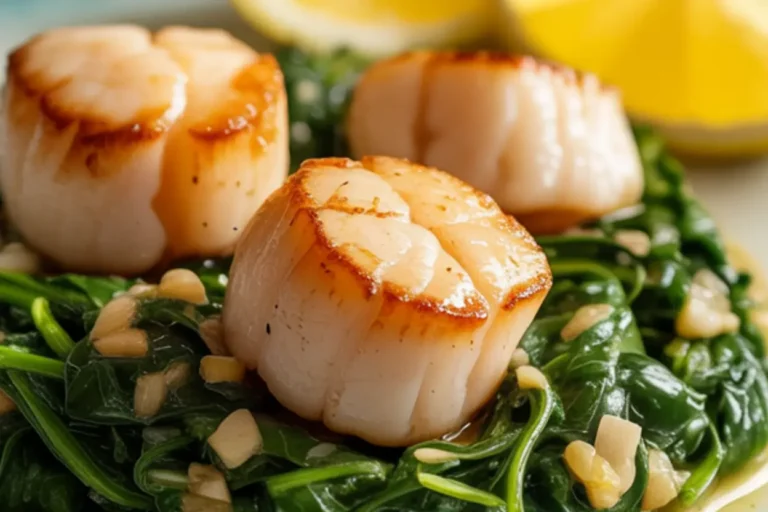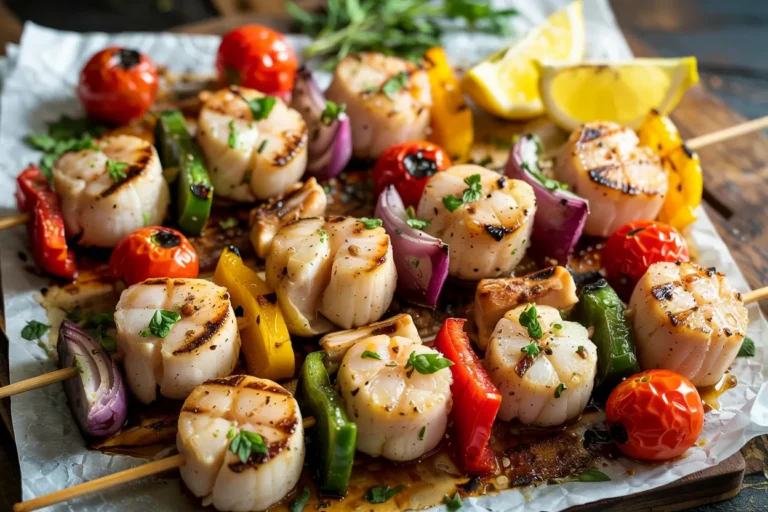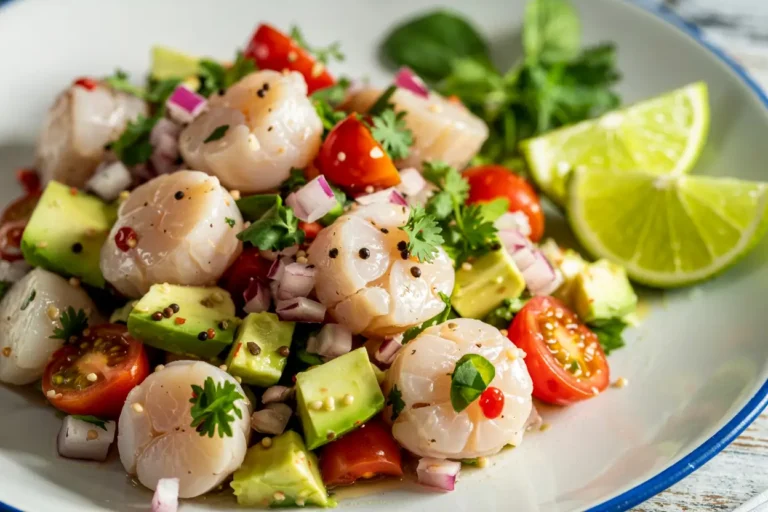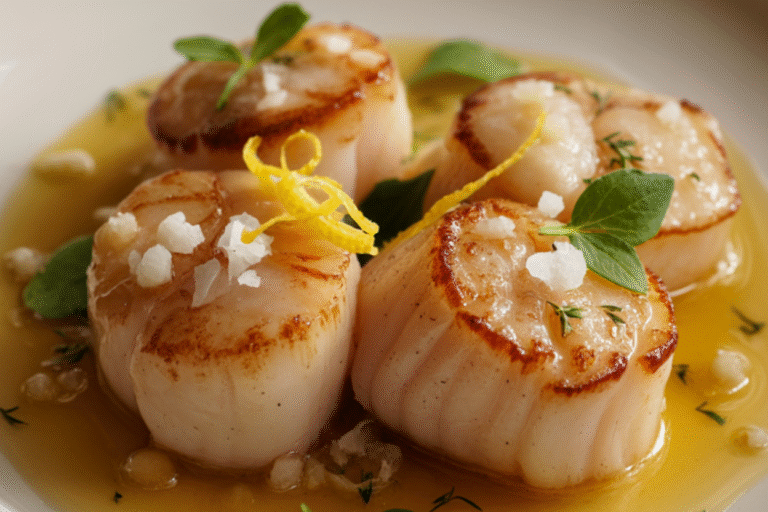Brown Butter Scallops with Polenta: how to get the sear right
Table of Contents
There’s a certain magic in perfectly seared scallops, the crisp, golden-brown crust revealing a tender, sweet center, which is the essence of fine dining. Yet so many home cooks shy away from preparing scallops, fearing they’ll never achieve restaurant-quality results. I’m here to tell you that with the right technique, you absolutely can master Brown Butter Scallops with Polenta in your own kitchen.
Thank you for reading this post, don't forget to subscribe!As someone who’s been perfecting this dish for years, I’ve discovered that the secrets to exceptional scallops are actually quite simple: quality ingredients, proper preparation, and precise timing. When paired with creamy polenta and nutty brown butter, these scallops create a dish that’s simultaneously elegant and comforting, perfect for impressing guests or elevating a weeknight meal for someone special.
How to Make Brown Butter Scallops with Polenta
Quick Overview
Brown Butter Scallops with Polenta combines the delicate sweetness of perfectly seared sea scallops with the rich comfort of creamy polenta, all brought together by the nutty depth of brown butter. What makes this dish truly special is the impressive contrast between the crisp, caramelized exterior of the scallops and their tender, almost buttery interior – a culinary feat that’s actually achievable with just a few key techniques.
The real stars of this dish are the contrasting textures and complementary flavors: the scallops provide a subtle sweetness that pairs beautifully with the earthy corn notes of the polenta, while the brown butter adds a complex nuttiness that elevates everything it touches. A hint of lemon brightens the rich flavors, and fresh herbs add a final aromatic touch.
Despite its restaurant-quality presentation, this elegant meal comes together in just about 30 minutes: 15 minutes for the polenta (most of which is hands-off simmering) and about 15 minutes for preparing and searing the scallops. It’s the perfect recipe for when you want maximum impact with minimal time investment.
The Ingredients I Use to Bring My Brown Butter Scallops with Polenta to Life
For the Creamy Polenta:
- 4 cups chicken broth or vegetable broth
- 1 cup stone-ground polenta (not quick-cooking)
- 1/2 teaspoon salt
- 1/4 teaspoon freshly ground black pepper
- 3 tablespoons unsalted butter
- 1/2 cup freshly grated Parmesan cheese
- 2 tablespoons heavy cream
For the Brown Butter Scallops:
- 12 large sea scallops (U-10 or U-12 size, approximately 1 pound)
- 2 tablespoons neutral oil with high smoke point (grapeseed, avocado, or refined olive oil)
- 4 tablespoons unsalted butter
- 2 garlic cloves, minced
- 2 teaspoons of fresh thyme leaves (with additional sprigs for garnish)
- 1 tablespoon fresh lemon juice
- 1 teaspoon lemon zest
- 1/4 teaspoon red pepper flakes (optional)
- Salt and freshly ground black pepper to taste
- 2 tablespoons fresh parsley, finely chopped (for garnish)
- Lemon wedges (for serving)
Step-by-Step Instructions
Preparing the Polenta
- Bring broth to a boil: In a medium saucepan, bring the 4 cups of broth to a rolling boil over high heat.
- Add polenta gradually: Reduce heat to medium-low. Slowly pour in the polenta while whisking constantly to prevent lumps from forming. This gradual addition is crucial for smooth polenta.
- Season and simmer: Add 1/2 teaspoon salt and 1/4 teaspoon black pepper. Reduce heat to low and simmer, stirring frequently with a wooden spoon, for about 25-30 minutes until the polenta is thick and creamy. Different brands may require slightly different cooking times, so follow package instructions for guidance.
- Enrich the polenta: Once the polenta has thickened to your desired consistency, remove from the heat and stir in the 3 tablespoons of butter until melted. Add the Parmesan cheese and heavy cream, stirring until completely incorporated and smooth.
- Keep warm: Cover the polenta to keep warm while you prepare the scallops. If it becomes too thick before serving, you can thin it with a little warm broth or cream and stir well.
Preparing and Cooking the Scallops
- Prepare the scallops: Place the scallops on a plate lined with paper towels. Pat them very dry on all sides with additional paper towels – this is absolutely critical for achieving a good sear. Remove the small side muscle (the rectangular tough piece on the side) if it’s still attached.
- Season properly: Just before cooking, season the scallops on both sides with salt and freshly ground black pepper. Seasoning too early can draw out moisture, so this should be done right before they hit the pan.
- Heat the pan properly: Place a large, heavy-bottomed skillet (preferably cast iron or stainless steel) over medium-high heat. Let it heat fully this typically takes 2–3 minutes. The pan is ready when a drop of water sizzles and instantly evaporates on contact.
- Add oil and arrange scallops: Add the neutral oil to the hot pan and swirl to coat the bottom. Using tongs, carefully place the scallops in the pan, leaving plenty of space between each one – overcrowding will cause them to steam rather than sear. If necessary, cook in batches rather than crowding the pan.
- Master the sear: Leave the scallops undisturbed for 2-3 minutes until a golden-brown crust forms on the bottom. Resist the urge to move them around or peek underneath too early – patience is key to developing a proper sear.
- Flip with care: Using tongs, carefully flip each scallop once and sear the second side for 1-2 minutes more. Properly cooked scallops should be slightly translucent in the very center – overcooking will make them tough and rubbery.
- Remove and rest: Transfer the seared scallops to a clean plate and tent loosely with foil to keep warm while you make the brown butter.
Creating the Brown Butter Sauce
- Reduce heat and wipe pan: Reduce the heat to medium and carefully wipe out any burned bits from the pan with a paper towel, leaving the flavorful fond (browned bits) intact.
- Brown the butter: Add the 4 tablespoons of butter to the pan. Allow it to melt completely, then continue cooking, swirling occasionally, until the butter begins to foam and the milk solids turn golden brown and develop a nutty aroma. This usually takes 3-4 minutes – watch carefully, as brown butter can quickly turn to burned butter.
- Add aromatics: When the butter has browned, stir in the minced garlic, thyme leaves, and red pepper flakes (if using). Sauté for about 30 seconds, just until fragrant, taking care not to let the garlic burn.
- Finish with acid: Remove the pan from the heat and stir in the lemon juice and zest, which will stop the cooking process and add brightness to the sauce. Add a pinch of salt and pepper, adjusting to taste.
Plating and Serving
- Spoon polenta onto plates: Divide the warm polenta among serving plates, creating a smooth base for the scallops.
- Arrange scallops: Place the seared scallops on top of the polenta, arranging them aesthetically.
- Sauce and garnish: Drizzle the brown butter sauce over and around the scallops and polenta. Sprinkle with the chopped parsley, additional fresh thyme if desired, and place a lemon wedge on each plate.
- Serve immediately: Brown Butter Scallops with Polenta is best enjoyed right away, while the scallops are warm and the contrasting textures are at their peak.
What to Serve Brown Butter Scallops with Polenta With
This elegant dish pairs beautifully with several accompaniments:
- Roasted asparagus or broccolini: The slightly charred, earthy vegetables provide a perfect color and texture contrast while complementing the richness of the dish.
- Simple arugula salad: Dress peppery arugula lightly with lemon juice, olive oil, and shaved Parmesan for a refreshing counterpoint to the rich scallops and polenta.
- Sautéed cherry tomatoes: Quick-sautéed cherry tomatoes with garlic and herbs add a burst of color and acidity that balances the dish beautifully.
- Crusty artisan bread: Perfect for sopping up any remaining brown butter sauce – too delicious to waste!
- Wine pairing: A crisp, unoaked Chardonnay or Sauvignon Blanc complements the sweetness of the scallops without overwhelming them. For non-alcoholic options, a sparkling water with a touch of lemon provides a refreshing contrast.
- For a complete menu: Start with a light soup like a chilled cucumber or tomato consommé, followed by the scallops as your main, and finish with a not-too-sweet dessert like a lemon panna cotta.
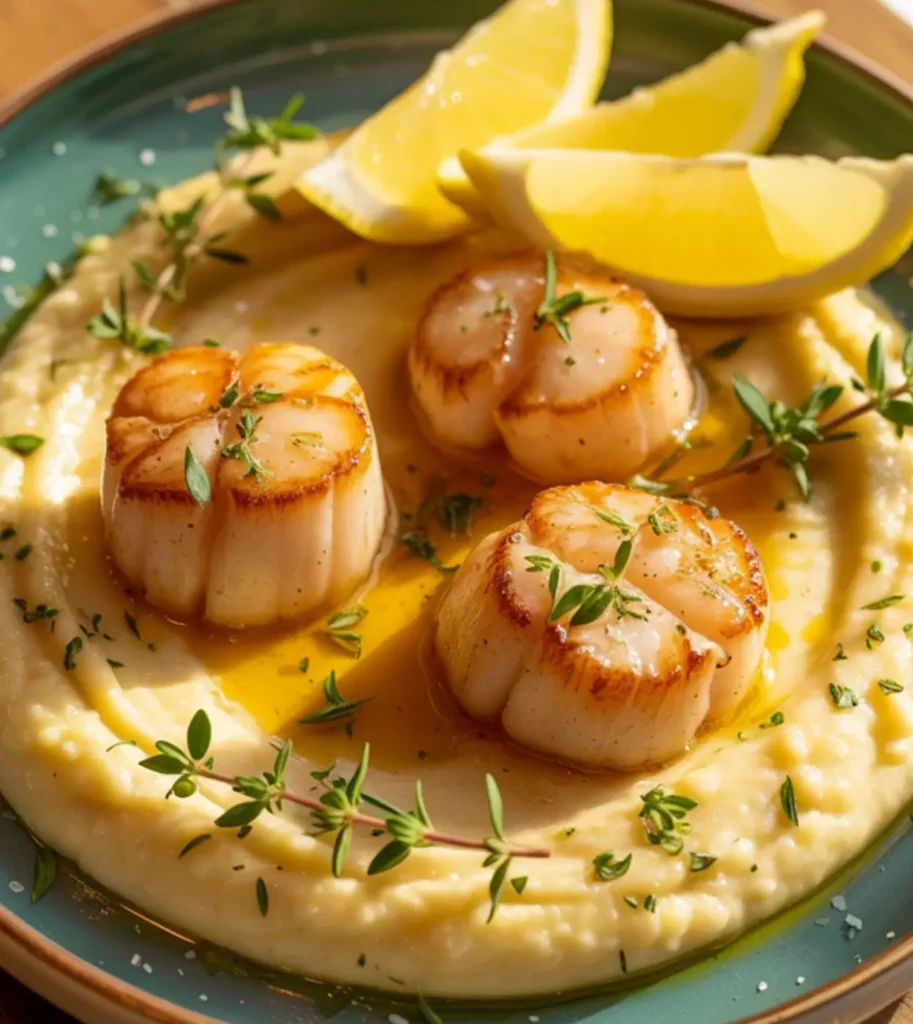
Top Tips for Perfecting Brown Butter Scallops with Polenta
- Scallop selection matters: Look for “dry-packed” scallops rather than “wet-packed.” Wet-packed scallops have been treated with a phosphate solution that causes them to absorb water, making them difficult to sear properly and giving them a slightly soapy taste.
- The secret to the perfect sear: Three factors are critical: thoroughly dry scallops, a very hot pan, and resisting the urge to move the scallops once placed in the pan. Any compromise on these points will result in less than ideal browning.
- Timing is everything: Scallops continue cooking slightly after being removed from the heat. For the ideal medium doneness, look for a translucent center when you cut into a test scallop. If they’re completely opaque throughout, they’re likely overcooked.
- Polenta patience: Good polenta can’t be rushed. The slow cooking process allows the corn to release its natural starches for the creamiest texture. If you’re truly pressed for time, you can use quick-cooking polenta, but the texture and flavor won’t be quite as rich.
- Brown butter vigilance: The difference between perfectly nutty brown butter and bitter burned butter is often just a matter of seconds. Stay by the stove and watch the color change carefully. It’s ready when it turns amber and gives off a rich, nutty aroma.
- Temperature management: If cooking scallops in batches, wipe the pan clean between batches and allow it to reheat properly. Adding scallops to a pan that isn’t hot enough will result in steaming rather than searing.
- Quality ingredients shine: With a dish this simple, ingredient quality is paramount. Use freshly grated Parmesan (not pre-grated), fresh herbs, and the highest quality scallops you can find.
- Size consistency: Try to select scallops of similar size to ensure even cooking. U-10 (meaning there are under 10 scallops per pound) or U-12 size are ideal for this dish.
- Make-ahead strategy: The polenta can be made up to an hour ahead and kept warm in a double boiler setup. The scallops, however, should be cooked just before serving.
- Room temperature butter: When browning butter, starting with room temperature butter rather than cold will help it melt more evenly and reduce splattering.
Storing and Reheating Tips
The Reality Check:
Let’s be honest – Brown Butter Scallops with Polenta is at its absolute peak when served fresh. The contrast between the crisp sear of the scallops and their tender interior is difficult to maintain once refrigerated and reheated. That said, if you do have leftovers:
Storing Polenta:
- Polenta can be refrigerated in an airtight container for up to 3 days.
- When refrigerated, polenta will solidify. This isn’t a flaw – it’s expected.
- You can also portion the polenta onto a baking sheet, allow it to cool and solidify, then cut into squares for future uses (like grilling or frying).
Storing Scallops:
- Store cooked scallops in an airtight container in the refrigerator for no more than 2 days.
- If possible, store the brown butter sauce separately from the scallops to prevent them from becoming soggy.
Reheating Polenta:
- The best method is on the stovetop: Place the solidified polenta in a saucepan with a splash of broth, milk, or cream.
- Heat over low heat, stirring constantly, until smooth and creamy again.
- You may need to add additional liquid to reach your desired consistency.
- Microwave method: Heat in a covered microwave-safe dish with a splash of liquid, stopping to stir every 30 seconds until smooth.
Reheating Scallops:
- Scallops are very delicate when it comes to reheating. The goal is to warm them without additional cooking.
- Gentle stovetop method: Heat a small amount of butter in a skillet over low heat, add the scallops, and warm for just 30-60 seconds per side.
- Microwave with caution: Place scallops on a microwave-safe plate and cover with a damp paper towel. Heat at 50% power for 20-second intervals until just warm.
Brown Butter Sauce:
- Refrigerated brown butter will solidify. Gently rewarm in a small saucepan over low heat just until melted.
- The sauce may separate slightly when reheated; whisk vigorously to recombine.
Alternative Use for Leftovers:
- Rather than trying to recreate the original dish, consider transforming leftovers:
- Chop cold scallops and mix with the polenta, form into cakes, and pan-fry for delicious seafood polenta cakes.
- Top with a fresh element like a tomato salsa or herb salad to compensate for any loss of texture in the reheated scallops.
Brown Butter Scallops with Polenta is one of those dishes that strikes the perfect balance between sophisticated and approachable. While achieving restaurant-quality scallops does require attention to detail, the techniques themselves are straightforward. Master this recipe, and you’ll not only have an impressive dish in your repertoire but also the confidence to tackle other seafood preparations that might have seemed intimidating before. The combination of sweet scallops, nutty brown butter, and creamy polenta creates a harmony of flavors and textures that’s sure to become a favorite for special occasions. With practice, you might find yourself making this dish regularly, simply because few things match the satisfaction of cutting into a perfectly seared scallop that you’ve cooked yourself.
Brown Butter Scallops with Polenta: how to get the sear right
Cuisine: AmericanDifficulty: Intermediate4
servings15
minutes30
minutes500-550
kcalA refined yet comforting dish, this recipe features perfectly seared sea scallops nestled on a bed of creamy, Parmesan-infused polenta. Finished with nutty brown butter, garlic, fresh thyme, and a touch of lemon, it strikes a beautiful balance between rich, savory flavors and bright, fresh notes perfect for an elegant dinner or a weekend indulgence.
Ingredients
4 cups chicken broth or vegetable broth
1 cup stone-ground polenta (not quick-cooking)
1/2 teaspoon salt
1/4 teaspoon freshly ground black pepper
3 tablespoons unsalted butter
1/2 cup freshly grated Parmesan cheese
2 tablespoons heavy cream
12 large sea scallops (U-10 or U-12 size, approximately 1 pound)
2 tablespoons neutral oil with high smoke point (grapeseed, avocado, or refined olive oil)
4 tablespoons unsalted butter
2 garlic cloves, minced
2 teaspoons of fresh thyme leaves (with additional sprigs for garnish)
1 tablespoon fresh lemon juice
1 teaspoon lemon zest
1/4 teaspoon red pepper flakes (optional)
Salt and freshly ground black pepper to taste
2 tablespoons fresh parsley, finely chopped (for garnish)
Lemon wedges (for serving)
Instructions
- Cook the Polenta
Bring broth to a boil, then gradually whisk in polenta. Season with salt and pepper, reduce heat, and simmer for 25–30 minutes, stirring frequently, until thick and creamy. Stir in butter, Parmesan, and heavy cream. Keep warm; thin with extra broth or cream if needed. - Sear the Scallops
Pat the scallops very dry and remove the side muscle if attached. Season just before cooking. Heat oil in a hot skillet, then add scallops without crowding. Sear undisturbed for 2–3 minutes until golden, flip, and cook 1–2 minutes more. Transfer to a plate and tent with foil. - Make Brown Butter Sauce
Lower the heat and wipe the pan clean. Add butter and cook until browned and nutty, about 3–4 minutes. Stir in garlic, thyme, and red pepper flakes (if using), and sauté 30 seconds. Remove from heat, then add lemon juice, zest, salt, and pepper. - Plate and Serve
Spoon polenta onto plates, top with seared scallops, and drizzle with brown butter sauce. Garnish with parsley, thyme sprigs, and lemon wedges. Serve immediately while warm and fresh.
Notes
- Using stone-ground polenta instead of quick-cooking varieties gives this dish a rustic texture and deep corn flavor that pairs beautifully with the richness of the scallops and brown butter. Be patient with searing the scallops a hot pan and dry surface are key to achieving that golden crust. The optional red pepper flakes add a subtle kick, but feel free to leave them out for a more delicate flavor profile.


